2019 MERCEDES-BENZ GLS SUV fuel
[x] Cancel search: fuelPage 6 of 729
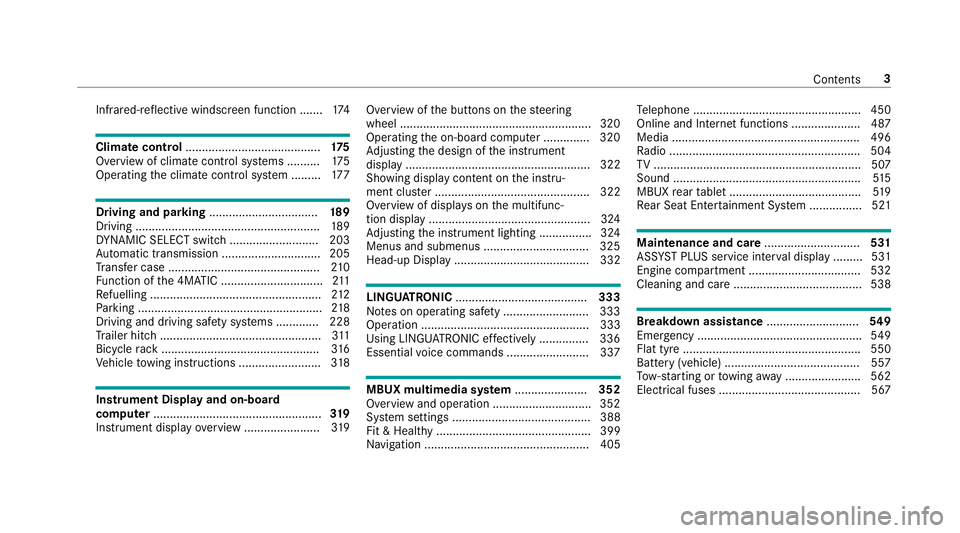
Infrared-reflective windscreen function .......
174Climate control
......................................... 175
Overview of climate contro l systems ..........1 75
Operating the climate control sy stem ......... 17 7 Driving and pa
rking ................................. 18 9
Driving ........................................................ 189
DY NA MIC SELECT switch ........................... 203
Au tomatic transmission .............................. 205
Tr ans fer case .............................................. 210
Fu nction of the 4MATIC ...............................2 11
Re fuelling .................................................... 212
Pa rking ........................................................ 218
Driving and driving sa fety sy stems .............2 28
Tr ailer hit ch................................................. 311
Bicycle rack ................................................ 316
Ve hicle towing instructions ........................ .318 Instrument Display and on-board
compu ter................................................... 319
Instrument display overview ...................... .319 Overview of
the buttons on thesteering
wheel ..........................................................3 20
Operating the on-board computer .............. 320
Ad justing the design of the instrument
display ........................................................ 322
Showing display conte nt onthe instru‐
ment clus ter ............................................... 322
Overview of displa yson the multifunc‐
tion display .................................................3 24
Ad justing the instrument lighting ................3 24
Menus and submenus ................................ 325
Head-up Display ......................................... 332 LINGU
ATRO NIC ........................................ 333
No tes on operating saf ety .......................... 333
Ope ration ................................................... 333
Using LINGU ATRO NIC ef fectively ............... 336
Essential voice commands ........................ .337 MBUX multimedia sy
stem ...................... 352
Overview and operation .............................. 352
Sy stem settings .......................................... 388
Fit & Healt hy............................................... 399
Na vigation .................................................. 405 Te
lephone .................................................. .450
Online and Internet functions ..................... 487
Media ........................................................ .496
Ra dio .......................................................... 504
TV ............................................................... 507
Sound ......................................................... 51 5
MBUX rear tablet ........................................ 519
Re ar Seat En tertainment Sy stem ................5 21 Maintenance and care
.............................531
ASS YST PLUS service inter val display ........ .531
Engine compartment .................................. 532
Cleaning and care ....................................... 538 Breakdown assistance
............................549
Emergency ................................................. .549
Flat tyre ...................................................... 550
Battery (vehicle) ......................................... 557
To w- starting or towing away ....................... 562
Electrical fuses ........................................... 567 Contents
3
Page 14 of 729

1
Speedom eter →
319
2 #! Turn signal indicators →
15 8
3 ï Trailer hit chis not operational or is swiv‐
elling →
677
4 Multifunction display →
324
5 6 Restra int sy stem →
37
6 Rev counter →
319
7 å ESP®
OFF →
666
÷ ESP®
→
666
8 R Rear fog light →
15 8
9 K High beam →
15 8
L Low beam →
157
T Standing lights →
157
A ? Coolant too hot/cold →
673
B Coolant temp erature display →
319
C ! Electric pa rking brake malfunctioning
(yellow) →
666 D
J Brakes (yellow) →
666
E ± Active Lane Change Assi st→
253
F L Distance warning →
672
G # Electrical fault →
673
H Ð Powe r-assis tedsteering malfunction →
677
I ! ABS malfunction →
666
J h Tyre pressure monitor →
675
K % Diesel engine: preglow
L 8 Fuelreser vewith fuel filler flap location
indicator →
673
M Fuel le vel display
N ! Electric parking brake applied (red) →
666
O J Brakes (red) →
666
P ü Seat belt not fastened →
671
Q ; Engine diagnosis →
673
R Suspension malfunction At
aglance – Warning and indicator lamps 11
Page 22 of 729
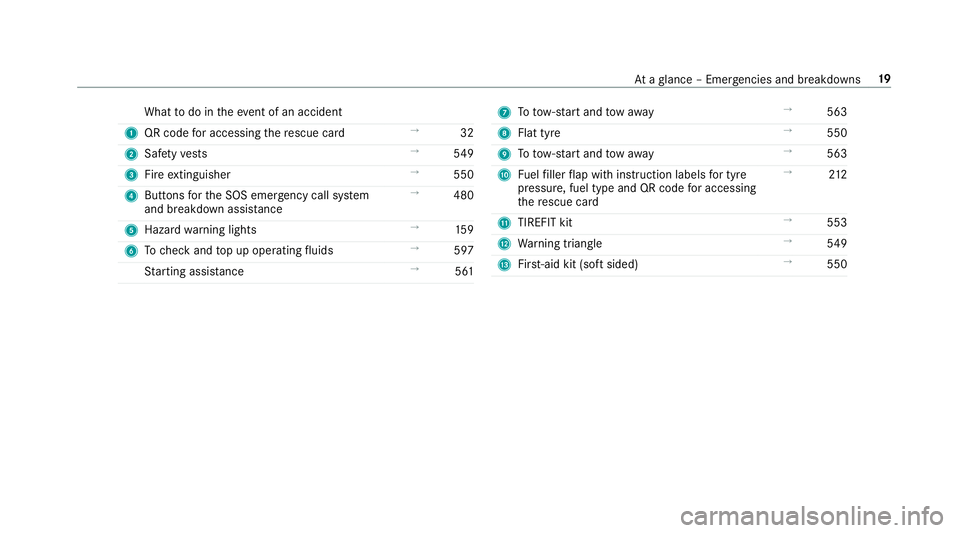
What
todo in theeve nt of an accident
1 QR code for accessing there scue card →
32
2 Safetyve sts →
549
3 Fire extinguisher →
550
4 Buttons forth e SOS emer gency call sy stem
and breakdown assis tance →
480
5 Haza rdwa rning lights →
15 9
6 Tocheck and top up operating fluids →
597
St arting assis tance →
561 7
Totow- start and tow aw ay →
563
8 Flat tyre →
550
9 Totow- start and tow aw ay →
563
A Fuelfiller flap with instruction labels for tyre
pressu re, fuel type and QR code for accessing
th ere scue card →
212
B TIREFIT kit →
553
C Warning triangle →
549
D First-aid kit (so ftsided) →
550 At
aglance – Emer gencies and breakdowns 19
Page 25 of 729
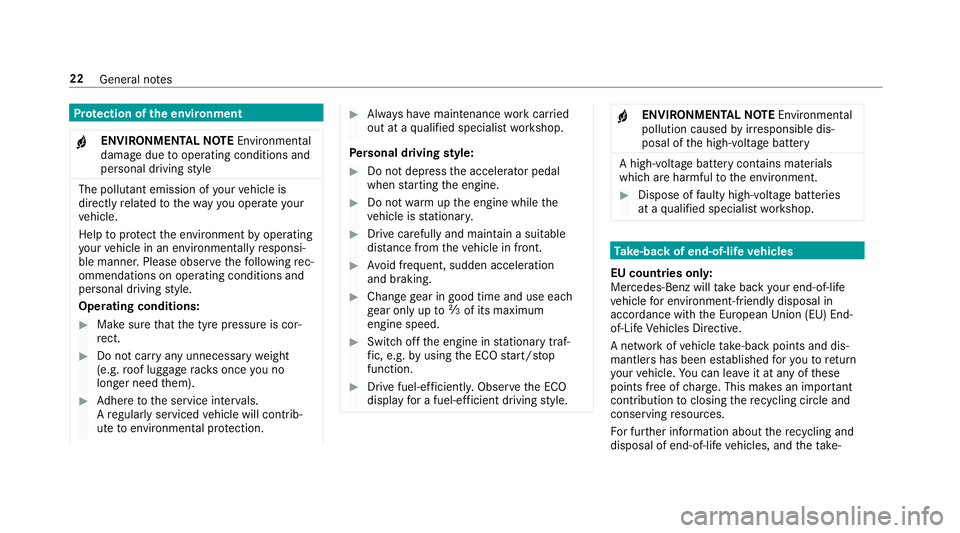
Pr
otection of the environment
+ ENVIRONMENTAL
NOTEEnvironmental
dama gedue tooperating conditions and
personal driving style The pollutant emission of
your vehicle is
directly related tothewa yyo u operate your
ve hicle.
Help toprotect the environment byoperating
yo ur vehicle in an environmentally responsi‐
ble manner. Please obser vethefo llowing rec‐
ommendations on ope rating conditions and
pe rsonal driving style.
Operating conditions: #
Make sure that the tyre pressure is cor‐
re ct. #
Do not car ryany unnecessary weight
(e.g. roof luggage rack s once you no
lon ger need them). #
Adhere tothe service inter vals.
A regularly serviced vehicle will contri b‐
ute toenvironmen tal pr otection. #
Alw ays ha vemaintenance workcar ried
out at a qualified specialist workshop.
Pe rsonal driving style: #
Do not depress the accelera tor pedal
when starting the engine. #
Do not warm upthe engine while the
ve hicle is stationar y. #
Drive carefully and maintain a suitable
di st ance from theve hicle in front. #
Avoid frequent, sudden acceleration
and braking. #
Change gear in good time and use each
ge ar on lyup toÔ of its maximum
engine speed. #
Switch off the engine in stationary traf‐
fi c, e.g. byusing the ECO start/ stop
function. #
Drive fuel-ef ficiently. Obser vethe ECO
display for a fuel-ef ficient driving style. +
ENVIRONMEN
TALNO TEEnvironmental
pollution caused byirre sponsible dis‐
posal of the high-voltage battery A high-voltage battery conta
ins materials
which are harmful tothe environment. #
Dispose of faulty high-voltage bat teries
at a qualified specialist workshop. Ta
ke -back of end-of-life vehicles
EU countries onl y:
Mercedes-Benz will take back your end-of-life
ve hicle for environment-friendly disposal in
accordance with the European Union(EU) End-
of-Life Vehicles Directive.
A network of vehicle take -ba ckpoints and dis‐
mantlers has been es tablished foryo uto return
yo ur vehicle. You can lea veit at any of these
points free of charge . This makes an impor tant
contribution toclosing there cycling circle and
conse rving resources.
Fo r fur ther information about there cycling and
disposal of end-of-li fevehicles, and theta ke- 22
General no tes
Page 35 of 729
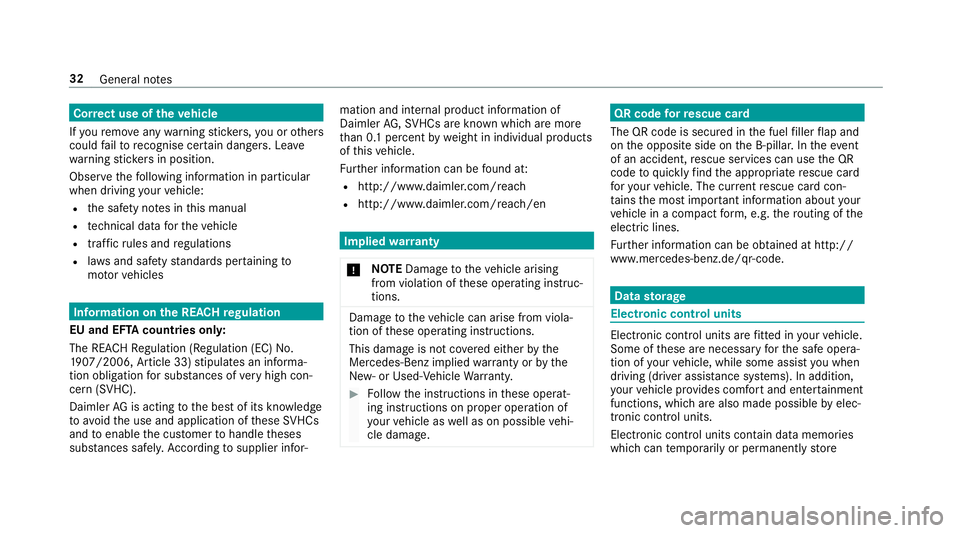
Cor
rect use of theve hicle
If yo ure mo veany warning sticke rs,yo u or others
could failto recognise cer tain dangers. Lea ve
wa rning sticke rs in position.
Obser vethefo llowing information in particular
when driving your vehicle:
R the saf ety no tes in this manual
R tech nical da taforth eve hicle
R traf fic ru les and regulations
R laws and saf etyst andards per taining to
mo torve hicles Information on
the REACH regulation
EU and EFTA countries onl y:
The REA CHRegulation (Regulation (EC) No.
19 07 /2006, Article 33) stipulates an informa‐
tion obligation for subs tances of very high con‐
cern (SVHC).
Daimler AGis acting tothe best of its know ledge
to av oidthe use and application of these SVHCs
and toenable the cus tomer tohandle theses
subs tances sa fely.Ac cording tosupplier infor‐ mation and internal product information of
Daimler AG,SV HCs are known whi chare more
th an 0.1 percent byweight in individual products
of this vehicle.
Fu rther information can be found at:
R http://www.daimler.com/ reach
R http://www.daimler.com/ reach/en Implied
warranty
* NO
TEDama getotheve hicle arising
from violation of these operating instruc‐
tions. Damage
totheve hicle can arise from viola‐
tion of these operating instructions.
This damage is not co vered either bythe
Mercedes-Benz implied warranty or bythe
New‑ or Used- Vehicle Warrant y. #
Follow the instructions in these operat‐
ing instructions on proper operation of
yo ur vehicle as well as on possible vehi‐
cle damage. QR code
forre scue card
The QR code is secured in the fuel filler flap and
on the opposite side on the B-pillar. In theeve nt
of an accident, rescue services can use the QR
code toquickly find the appropriate rescue card
fo ryo ur vehicle. The cur rent rescue card con‐
ta ins the most impor tant information about your
ve hicle in a compact form , e.g. thero uting of the
electric lines.
Fu rther information can be obtained at http://
www.mercedes-benz.de/qr-code. Data
storage Electronic control units
Elect
ronic control units are fitted in your vehicle.
Some of these are necessary forth e safe opera‐
tion of your vehicle, while some assist you when
driving (driver assis tance sy stems). In addition,
yo ur vehicle pr ovides com fort and enter tainment
functions, which are also made possible byelec‐
tronic control units.
Elect ronic control units contain da tamemories
which can temp orarily or permanently store 32
General no tes
Page 85 of 729
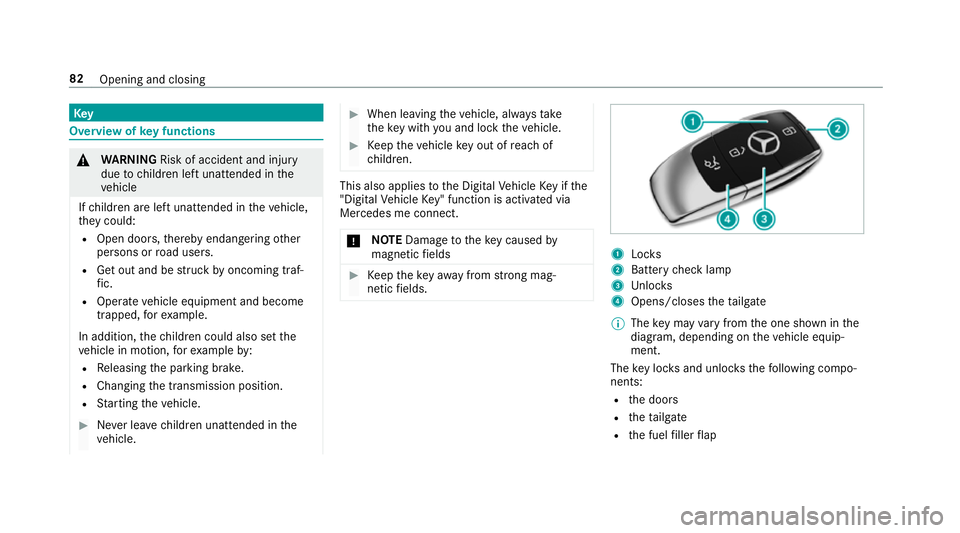
Key
Overview of
key functions &
WARNING Risk of accident and inju ry
due tochildren left unat tended in the
ve hicle
If ch ildren are left unat tended in theve hicle,
th ey could:
R Open doo rs,th ereby endangering other
persons or road users.
R Get out and be stru ck byoncoming traf‐
fi c.
R Ope rate ve hicle equipment and become
trapped, forex ample.
In addition, thech ildren could also set the
ve hicle in motion, forex ample by:
R Releasing the parking brake.
R Changing the transmission position.
R Starting theve hicle. #
Never lea vechildren unat tended in the
ve hicle. #
When leaving theve hicle, alw aysta ke
th eke y with you and lock theve hicle. #
Keep theve hicle key out of reach of
ch ildren. This also applies
tothe Digital Vehicle Key if the
"Digital Vehicle Key" function is activated via
Mercedes me connect.
* NO
TEDama getotheke y caused by
magnetic fields #
Keep theke yaw ay from strong mag‐
netic fields. 1
Locks
2 Battery check lamp
3 Unloc ks
4 Opens/closes theta ilgate
% The key may vary from the one shown in the
diagram, depending on theve hicle equip‐
ment.
The key loc ksand unlo cksth efo llowing compo‐
nents:
R the doors
R theta ilgate
R the fuel filler flap 82
Opening and closing
Page 86 of 729
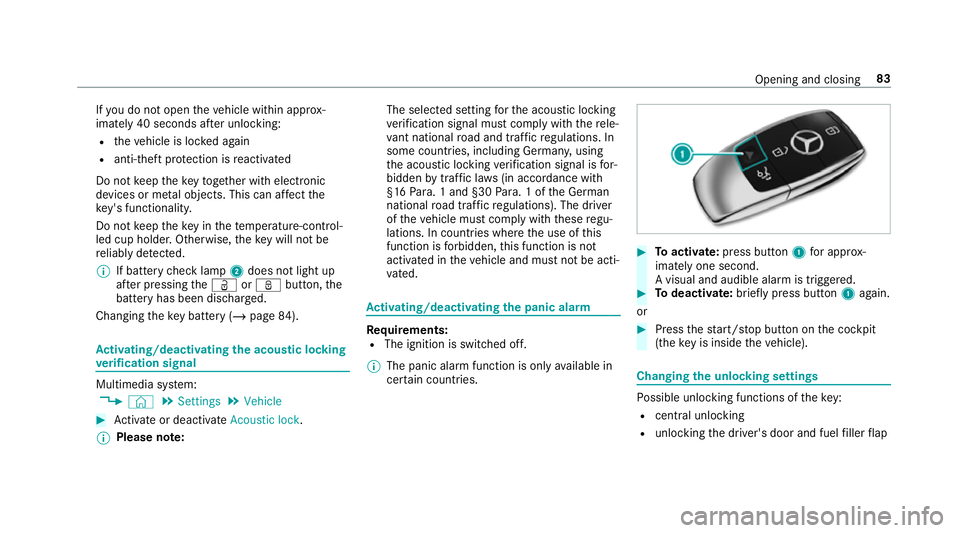
If
yo u do not open theve hicle within appr ox‐
imately 40 seconds af ter unlocking:
R theve hicle is loc ked again
R anti- theft pr otection is reactivated
Do not keep theke yto ge ther with electronic
devices or me tal objects. This can af fect the
ke y's functionalit y.
Do not keep theke y in thete mp erature-contro l‐
led cup holder. Otherwise, theke y will not be
re liably de tected.
% If battery check lamp 2does not light up
af te r pressing theÜ orß button, the
battery has been dischar ged.
Changing theke y bat tery ( / page 84). Ac
tivating/deactivating the acoustic lo cking
ve rification signal Multimedia sy
stem:
4 © 5
Settings 5
Vehicle #
Activate or deacti vate Acoustic lock .
% Please no
te: The selected setting
forth e acoustic locking
ve rification signal must comply wi th there le‐
va nt national road and traf fic re gulations. In
some countri es, including German y,using
th e acoustic locking verification signal is for‐
bidden bytraf fic la ws(in accordance with
§16 Para. 1 and §30 Para. 1 of the German
national road traf fic re gulations). The driver
of theve hicle must comply with these regu‐
lations. In countri es wherethe use of this
function is forbidden, this function is not
activated in theve hicle and must not be acti‐
va ted. Ac
tivating/deactivating the panic alarm Re
quirements:
R The ignition is switched off.
% The panic alarm function is only available in
cer tain countries. #
Toactivate: press button 1for appro x‐
ima tely one second.
A visual and audible alarm is triggered. #
Todeactivate: briefly press but ton1 again.
or #
Press thest art/ stop button on the cockpit
(the key is inside theve hicle). Changing
the unlocking settings Po
ssible unlocking functions of theke y:
R cent ral unlocking
R unlocking the driver's door and fuel filler flap Opening and closing
83
Page 87 of 729

#
Toswitch between settings: pressthe
Ü andß buttons simul taneously for
appr oximately six seconds until the battery
ch eck lamp flashes twice.
If th e unlocking function forth e driver's door
and fuel filler flap has been selec ted:
R pressing theÜ button a second time cen‐
trally unloc kstheve hicle
R Vehicles with KEYLESS-GO: ifyo uto uch
th e inner sur face of the door handle on the
driver's door, only the driver's door and fuel
fi ller flap are unlo cked. Deactivating
theke y functions If
yo u do not use theve hicle or a keyfo r an
ex tended pe riod of time, you can reduce the
energy consum ption of there spective key.Todo
so, deactivate theke y functions. #
Todeactivate: presstheß button on the
ke y twice in quick succession.
The battery check lamp of theke yflashes
twice brief lyand lights up once. #
Toactivate: press any button on thekey. %
When theve hicle is star ted with theke y in
th estow age compartment of the cent recon‐
sole, theke y functions are automatical ly
activated (/ page192). Re
moving/inserting the eme rgency key #
Toremo ve:press release button 1.
Emer gency key2 is pushed out slight ly. #
Pull out emer gency key2 until it en gage s in
th e intermediate position.
% You can use the intermediate position of
emer gency key2 toattach theke yto akey
ri ng. #
Press release button 1again and fully
re mo veemer gency key2. #
Toinser t:press release button 1. #
Insert emer gency key2 tothe intermediate
position or fully until it engages. Re
placing the key battery &
DANG ER Serious damage tohealth
caused byswallowing batteries
Batteries contain toxic and cor rosive sub‐
st ances. Swallowing bat teries may cause
serious damage tohealth.
There is a risk of fata l injur y. #
Keep batteries out of there ach of chil‐
dren. #
If batteries are swallo wed, seek medical
attention immediately. 84
Opening and closing